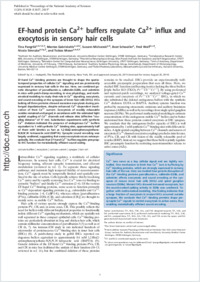EF-hand protein Ca²⁺ buffers regulate Ca²⁺ influx and exocytosis in sensory hair cells
- Pangršič, Tina Institute for Auditory Neuroscience and InnerEarLab, University Medical Center Göttingen, Germany
- Gabrielaitis, Mantas Institute for Auditory Neuroscience and InnerEarLab, University Medical Center Göttingen, Germany
- Michanski, Susann Institute for Auditory Neuroscience and InnerEarLab, University Medical Center Göttingen, Germany
- Schwaller, Beat Unit of Anatomy, Department of Medicine, University of Fribourg, Switzerland
- Wolf, Fred Collaborative Research Center 889, University of Göttingen, Germany
- Strenzke, Nicola Collaborative Research Center 889, University of Göttingen, Germany
- Moser, Tobias Institute for Auditory Neuroscience and InnerEarLab, University Medical Center Göttingen, Germany
-
03.03.2015
Published in:
- Proceedings of the National Academy of Sciences. - 2015, vol. 112, no. 9, p. E1028–E1037
English
EF-hand Ca²⁺-binding proteins are thought to shape the spatiotemporal properties of cellular Ca²⁺ signaling and are prominently expressed in sensory hair cells in the ear. Here, we combined genetic disruption of parvalbumin-α, calbindin-D28k, and calretinin in mice with patch-clamp recording, in vivo physiology, and mathematical modeling to study their role in Ca²⁺ signaling, exocytosis, and sound encoding at the synapses of inner hair cells (IHCs). IHCs lacking all three proteins showed excessive exocytosis during prolonged depolarizations, despite enhanced Ca²⁺-dependent inactivation of their Ca²⁺ current. Exocytosis of readily releasable vesicles remained unchanged, in accordance with the estimated tight spatial coupling of Ca²⁺ channels and release sites (effective “coupling distance” of 17 nm). Substitution experiments with synthetic Ca²⁺ chelators indicated the presence of endogenous Ca²⁺ buffers equivalent to 1 mM synthetic Ca²⁺-binding sites, approximately half of them with kinetics as fast as 1,2-Bis(2-aminophenoxy)ethane-N,N,N′,N′-tetraacetic acid (BAPTA). Synaptic sound encoding was largely unaltered, suggesting that excess exocytosis occurs extrasynaptically. We conclude that EF-hand Ca²⁺ buffers regulate presynaptic IHC function for metabolically efficient sound coding.
- Faculty
- Faculté des sciences et de médecine
- Department
- Département de Médecine
- Language
-
- English
- Classification
- Biological sciences
- License
- License undefined
- Identifiers
-
- RERO DOC 235564
- DOI 10.1073/pnas.1416424112
- Persistent URL
- https://folia.unifr.ch/unifr/documents/304218
Statistics
Document views: 61
File downloads:
- sch_ehp.pdf: 198
